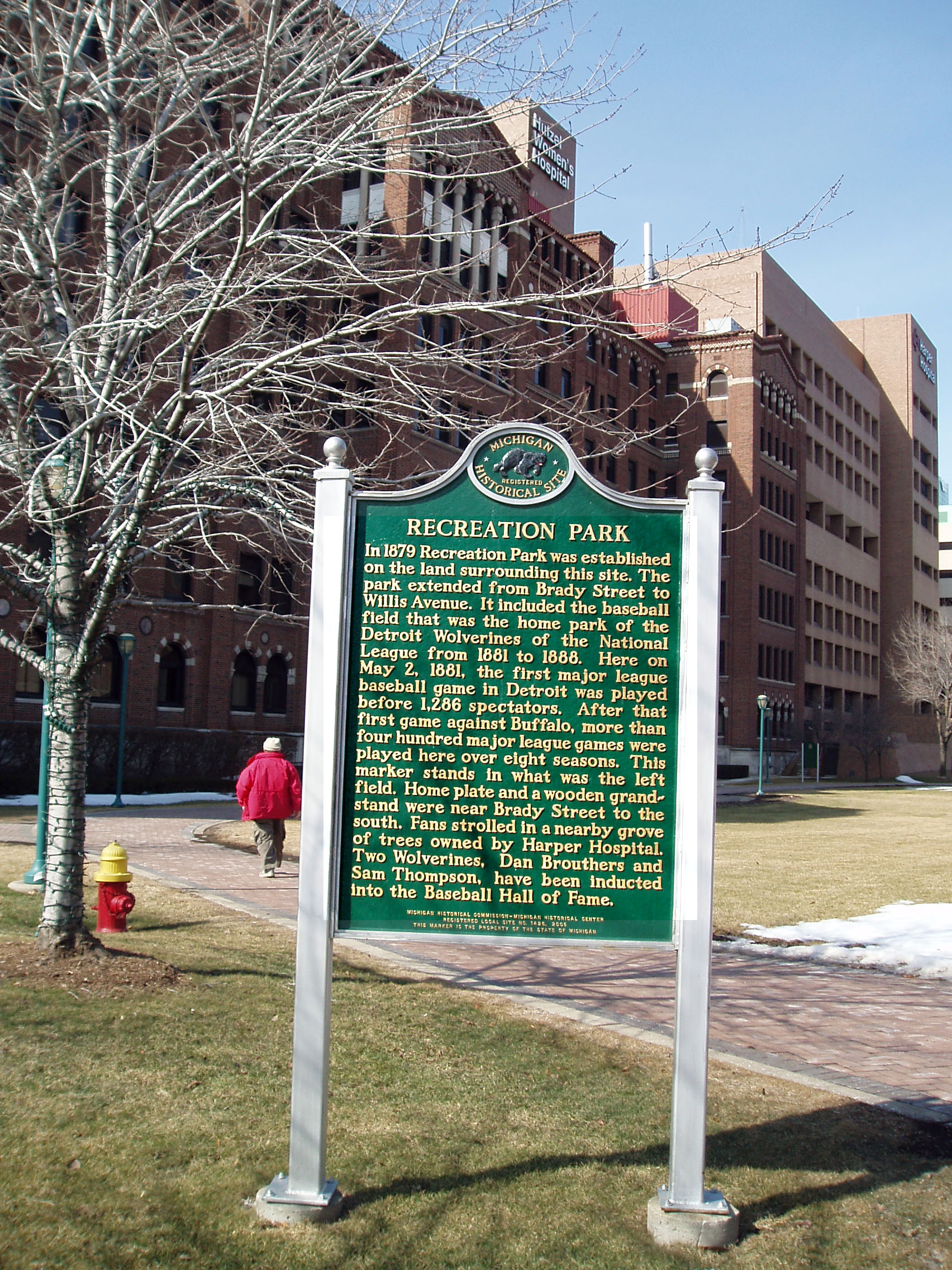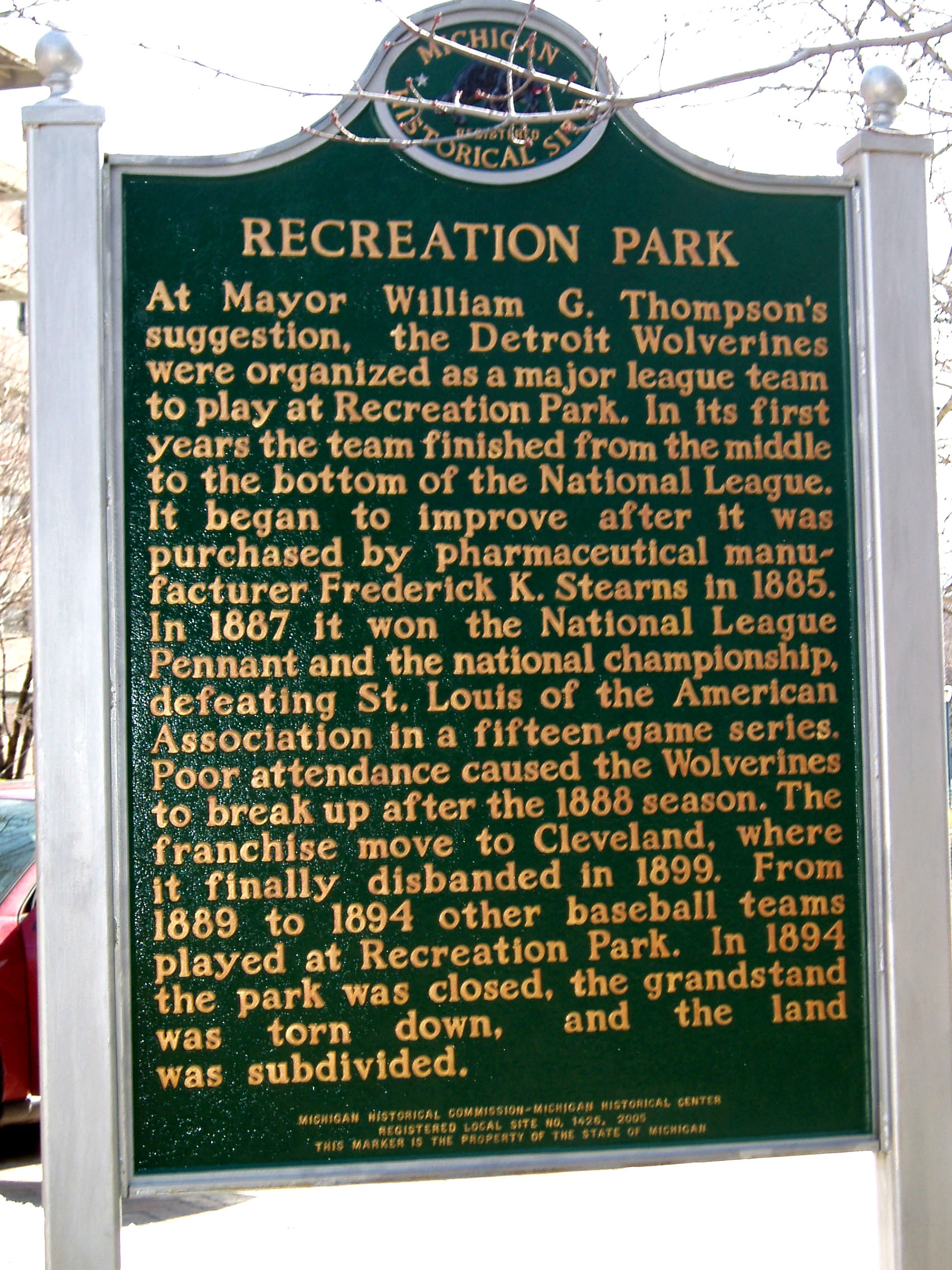

About a decade or so after the Civil War, social and economic trends in the larger cities of the United States generated a sizable population of prosperous men who had the time and resources to enjoy sports, including spectator sports. Baseball became the first popular spectator sport in this country. Entrepreneurs realized there was a new market for sports and entertainment in growing places such as Detroit.
A group of Detroit investors, in the late 1870s, built a recreational facility close to downtown. I infer that they rented land that belonged to Harper Hospital and created an 18-acre facility that, Richard Bak tells us in his book, A Place for Summer: A Narrative History of Tiger Stadium, (Detroit: Wayne State University Press, 1998), included tennis courts, an archery range, a cricket grounds, a track three-quarters of a mile in length and facilities for lacrosse and croquet. Professional baseball was increasingly popular in East Coast cities and the first organized major league, the National League, began operating in 1876. The investors in Recreation Park built stands for 1,000 patrons and recruited a professional team. The team, not part of any organized league, played its first home game against the Troy Trojans of the National League on May 10, 1879. The Detroit professional team, however, disbanded before that summer was over, presumably for financial reasons.
At the start of the 1880s, Mayor William Thompson
recognized the importance of major league baseball, and wanted to add Detroit
to the
National League.
Cincinnati had had a franchise since 1876, but other owners of other franchises
were upset with those who ran the Cincinnati Reds. Some of the league administrators
wanted to appeal to a broad audience. Cincinnati had an unusually large Catholic
and Jewish population. By 1880, Protestants in numerous cities had banned many
activities on Sundays, and were eventually successful in amending the federal
constitution to prohibit alcoholic beverages. The Cincinnati baseball team
not only scheduled games for Sundays, but sold both beer and liquor to their
patrons. The other owners apparently decided to drop Cincinnati from the National
League after the 1880 season. Mayor Thompson purchased the Reds and moved the
team to Detroit, giving the city its first major league professional sports
team.  They
were known as the Wolverines. Thompson served as president and owner of the
team, and ran the franchise from his office in City Hall. The first game,
against the Buffalo Bisons, was played at Recreation Park on May 2, 1881. The
team got off to a strong start but, in both 1881 and 1882, their play was not
spectacular. They finished with a 41 and 43 record in 1881 and 42 and 41 the
next year.
They
were known as the Wolverines. Thompson served as president and owner of the
team, and ran the franchise from his office in City Hall. The first game,
against the Buffalo Bisons, was played at Recreation Park on May 2, 1881. The
team got off to a strong start but, in both 1881 and 1882, their play was not
spectacular. They finished with a 41 and 43 record in 1881 and 42 and 41 the
next year.
Mayor Thompson sold the Detroit Wolverines to businessman Joseph Marsh prior to the 1883 season. Their performance declined and, in 1884, they compiled the worse record in Detroit major league history by winning just 25 percent of their games. The Detroit Tigers in 2003 approached a modern record for baseball futility, but they won 26 percent of their games, leaving in tact the record poor performance of Detroit’s 1884 Wolverines. The 1885 team improved a bit on the 1884 team, winning 38 percent of their games.
Following that season, the team was purchased by Frederick Stearns, the son of the man who developed the immensely successful Stearns pharmaceutical firm whose large building—now condominiums—stands on East Jefferson between Sheridan and Heyburn. Frederick Stearns played baseball at the University of Michigan, then organized a team of his own and apparently had an interest in the success of major league baseball in Detroit. Almost every year in the 1880s, National Leagues franchises were shifted from one city to another because of financial troubles. The Buffalo Bisons team was terminated at the end of the 1885 season and Frederick Stearns purchased their starting infielders—Dan Brouthers at first, Hardy Richardson at second, Jack Rowe at short and Deacon White at third. This greatly improved the team, and the 1886 Detroit Wolverines continue to hold the record for their winning performance. They won 87 games and lost but 36, giving them a .707 playing percentage. The best the Detroit Tigers American League team has ever accomplished was in their 1984 World Championship year when they played .642 ball during the regular season.
Despite winning 71 percent of their games in 1886, the Detroit Wolverines ended the season several games behind the Chicago White Stockings, managed by Cap Anson. The Wolverines’ performance fell off a bit in 1887 when they finished 79 and 45—a .637 record. Nevertheless, they won the National League flag. Although there was much doubt about whether there was any other major league of professional baseball teams, the Detroit Wolverines played the St. Louis Browns of the American Association, managed by Charley Comiskey for the World Championship. This was a 15-game series played in ten different cities. Indeed, only two of the games were at Recreation Park in Detroit. Detroit won 12 of the games and claimed the world championship.
The next year was a disappointing one for the Wolverines, and their record fell to 68 wins and 63 losses. Just after the end of the season, Frederick Stearns and other owners announced that they had lost much money on the team. They disbanded the team, sold the players, and the league moved the franchise to Cleveland. Sports writers and fans, however, felt the owners were taking their money and running away from baseball.
Charlie Bennett, a catcher for all eight years of Detroit National League history, was probably the Wolverine’s most popular player. Indeed, the first ballpark erected in 1896 near the corner of Michigan and Trumbull where Tiger Stadium now stands, was named for him. I believe that he was associated with the Detroit Tigers until his death in the mid-1920s. Three members of the Detroit Wolverines were elected to baseball’s Hall of Fame. Ned Hanlon, born in Montville, Connecticut in 1857, was an outfielder each year Detroit fielded a National League team. He finished his career with a .260 batting average and went on to manage teams in the National League for 18 years. Dan Brouthers, born in Sylvan Lake, New York in 1858, played first base for the Wolverines from 1886 through 1888. He was, arguably, baseball’s best hitter in the later years of the Nineteenth Century and finished his career with a .342 batting average. Sam Thompson, born in Danville, Indiana in 1860, played with the Wolverines from 1885 through 1888. He had 166 runs-batted-in 127 games in 1887. He was one of the leading power hitters of his era, hitting 20 home runs in 1889 for the Philadelphia Phillies. I believe Sam Thompson was the only one player who performed for both the National League Wolverines and then, in 1906 for Detroit’s American League Tigers. For a few games in that 1906 season, the Tigers had three Hall of Famers playing together in their outfield: Ty Cobb, Wahoo Sam Crawford and Sam Thompson.
In 1889, a local entrepreneur organized a
professional baseball team for a newly organized minor league—the International
Association—with teams in Buffalo, Detroit, Hamilton, London, Rochester, Syracuse,
Toledo and Toronto.
They played at Recreation Park that year and the next. In 1891, Detroit fielded
a minor league team in the Northwestern League. They began their season playing
at Recreation Park, but then switched to a new facility built in Hamtramck
Township at the corner of East Grand and East Jefferson in hopes of playing
games on
Sundays. Alas, the team did not survive to the end of the 1891 season. Early
in the 1890s, Recreation Park was closed for an expansion of Harper
Hospital.
Professional baseball disappeared from Detroit until Los Angeles resident George
Vanderbeck obtained a franchise in the Western League, a team that began play
in 1894 in a park at Helen and East Lafayette. By 1896, they moved to where
Tiger Stadium now stands and, in 1901, joined the American League once again
bringing major league baseball to Detroit.
So far as I know, there is no book that focuses upon Detroit’s National
League team. Richard Bak, in the book mentioned above, provides extensive information
about the Wolverines, but the definitive book about them has yet to be written.
In 2013, the new owners of the Chicgao Cubs sought municipal approval for a substantial remodeling of venerable Wrigley Field where I watched Ernie Banks play many times with a student at the University of Chicago. Among other changes, the owners proposed building a massive scoreboard that would block the view of the playing field from the roofs of neighboring buildings. The owners of those buildings have erected bleacher seats on their roofs and charge admission to watch the Cubs' games. They threated to sue the Cubs to block the construction of a scoreboard that would greatly diminish the revenue they derive from their properties.
This is not a new issue. Detroit resident John Deppert owned a barn that was located on property adjectent to Recreation Park. He erected bleachers on the roof of his barm and, in the summer of 1885, charged fans 25 cents to sit there. He also sold them apples and lemonade. The least expensive seats inside Recreation Park cost 50 cents. The team knew that Deppert was reducing their income since he attracted 25 to 100 fans for every home game. To thwart his business, the team built a nine foot fence around the park and hung cloths. This was ineffective so, on July 13, 1885, President Joseph Marsh of the Detroit Baseball Club went to the Superior Court of the City of Detroit seeking an injunction that would prohibit John Deppert from selling tickets to his barn's roof.
On February 4, 1886; the Superior Court dismissed the club's request for an injunction noting Mr. Deppert's property rights. The Detroit Baseball Club then appealed to the Supreme Court of the State of Michigan. In a learned legal appeal, they raised many issues about property rights and cited many decisions that protected an owner's rights from encroachment by another property owner. The issue came down to the property rights of the two parties. On April 27, 1886; the Michigan Supreme Court, in a three to one decision, ruled in favor of John Deppert.
City of Detroit Designated Historic District: Not listed
State of Michigan Registry of Historic Places: P 25,207 Listed June 10, 1987
State of Michigan Historic Marker: Put in place September 29, 1987. This is
located in the interior courtyard or mall of Harper Hospital at, approximately,
the point where Brush and Parsons would intersect were it not for the many hospital buildings.
National Register of Historic Places: Not listed
Description updated: May, 2013
Return to Registered Historic Districts, Structures and Historic Sites
Return to Sports, Parks and Recreation